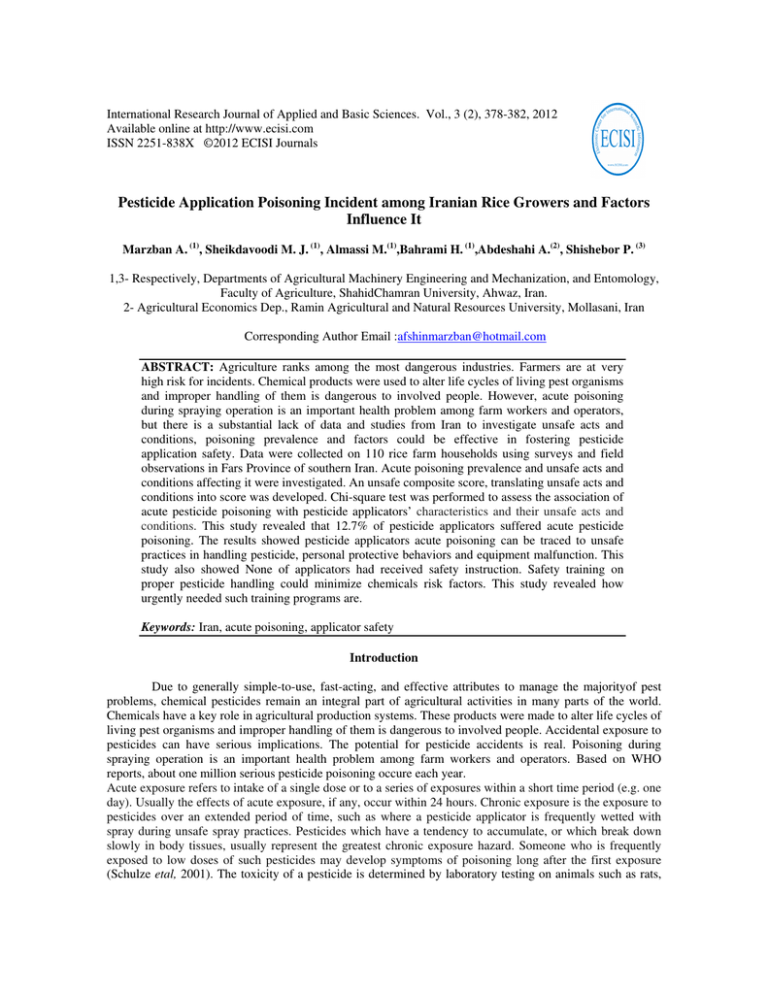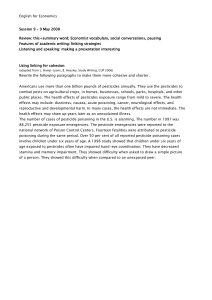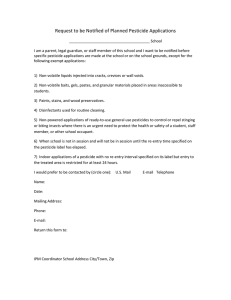Pesticide Application Poisoning Incident among Iranian Rice
advertisement

International Research Journal of Applied and Basic Sciences. Vol., 3 (2), 378-382, 2012 Available online at http://www.ecisi.com ISSN 2251-838X ©2012 ECISI Journals Pesticide Application Poisoning Incident among Iranian Rice Growers and Factors Influence It Marzban A. (1), Sheikdavoodi M. J. (1), Almassi M.(1),Bahrami H. (1),Abdeshahi A.(2), Shishebor P. (3) 1,3- Respectively, Departments of Agricultural Machinery Engineering and Mechanization, and Entomology, Faculty of Agriculture, ShahidChamran University, Ahwaz, Iran. 2- Agricultural Economics Dep., Ramin Agricultural and Natural Resources University, Mollasani, Iran Corresponding Author Email :afshinmarzban@hotmail.com ABSTRACT: Agriculture ranks among the most dangerous industries. Farmers are at very high risk for incidents. Chemical products were used to alter life cycles of living pest organisms and improper handling of them is dangerous to involved people. However, acute poisoning during spraying operation is an important health problem among farm workers and operators, but there is a substantial lack of data and studies from Iran to investigate unsafe acts and conditions, poisoning prevalence and factors could be effective in fostering pesticide application safety. Data were collected on 110 rice farm households using surveys and field observations in Fars Province of southern Iran. Acute poisoning prevalence and unsafe acts and conditions affecting it were investigated. An unsafe composite score, translating unsafe acts and conditions into score was developed. Chi-square test was performed to assess the association of acute pesticide poisoning with pesticide applicators’ characteristics and their unsafe acts and conditions. This study revealed that 12.7% of pesticide applicators suffered acute pesticide poisoning. The results showed pesticide applicators acute poisoning can be traced to unsafe practices in handling pesticide, personal protective behaviors and equipment malfunction. This study also showed None of applicators had received safety instruction. Safety training on proper pesticide handling could minimize chemicals risk factors. This study revealed how urgently needed such training programs are. Keywords: Iran, acute poisoning, applicator safety Introduction Due to generally simple-to-use, fast-acting, and effective attributes to manage the majorityof pest problems, chemical pesticides remain an integral part of agricultural activities in many parts of the world. Chemicals have a key role in agricultural production systems. These products were made to alter life cycles of living pest organisms and improper handling of them is dangerous to involved people. Accidental exposure to pesticides can have serious implications. The potential for pesticide accidents is real. Poisoning during spraying operation is an important health problem among farm workers and operators. Based on WHO reports, about one million serious pesticide poisoning occure each year. Acute exposure refers to intake of a single dose or to a series of exposures within a short time period (e.g. one day). Usually the effects of acute exposure, if any, occur within 24 hours. Chronic exposure is the exposure to pesticides over an extended period of time, such as where a pesticide applicator is frequently wetted with spray during unsafe spray practices. Pesticides which have a tendency to accumulate, or which break down slowly in body tissues, usually represent the greatest chronic exposure hazard. Someone who is frequently exposed to low doses of such pesticides may develop symptoms of poisoning long after the first exposure (Schulze etal, 2001). The toxicity of a pesticide is determined by laboratory testing on animals such as rats, Intl. Res. J. Appl. Basic. Sci. Vol., 3 (2), 378-382, 2012 mice and rabbits. The measuring method, LD50 (lethal dose, 50 percent), describes the dose of a pesticide that will kill half of a group of test animals from a single exposure (dose) by either the dermal, oral or inhalation routes (Matthews, 2008). In 2008 year, more than 26 million liters of pesticide were used in Iran (Baghestani, 2009). Despite this concentration of chemicals in the Iran agricultural, there are no studies on farmworker safety and risky behavior to pesticide exposure. Little studies conducted only surveyed Farmers' knowledge of occupational poisonings and their perceptions and attitudes in this area (Hosseini etal, 2009; Ghasemi and karami, 2009). But there is a substantial lack of data and studies to investigate unsafe acts and conditions, poisoning prevalence and factors could be effective in fostering pesticide application safety in Iran Agricultural sector. This study was conducted by the need to document the acute pesticide poisoning and factors affecting it among applicators in rice cash crop in Iran. Materials and Methods In this study rice growers of Beiza district in Fars province were surveyed about pesticide poisoning signs and symptoms they suffered during or whithin 24 hours after spraying. They also were asked about safety knowledge, personal protective equipments (PPEs), spraying equipment malfunction, socioeconomic parameteres such as age, formal education, and other safe or unsafe acts and conditions. Data were collected on 110 rice farm households. Pesticide Applicators who reported to have two or more symptoms whithin 24 hours after spraying were considered to have suffered acute pesticide poisoning (Schulze etal, 2001; Mancini etal, 2005). Data were analyzed with SPSS statistics software. Chi-square test was performed to assess the association of acute pesticide poisoning with pesticide applicator characteristics and safe or unsafe acts and conditions. The correlation between unsafe composite score and acute poisoning were examined. For this purpose based on the literature, we asked the respondents about nine safe or unsafe acts and conditions that were thought to increase the risk of acute pesticide poisoning (Cabrera, N. L. 2009; Zhang etal, 2011, Arcury etal. 2002; John Deere Co., 1984) Respondents could answer yes, no, or don’t know. The questions are listed below: 1. Did you read pesticides labels to acquire safety information before application? (no= 1, yes = 0) 2. Did you prepare pesticides with bare hand? (no =0, yes = 1) 3. Did you use personal protecting equipment/clothing during application? (no = 1, yes = 0) 4. Did you eat, drink or use tobacco during application? (yes = 1, no = 0) 5. Did you wipe sweat with your hands during application? (yes = 1, no = 0) 6. Was your spraying equipment leaking during application? (yes = 1, no = 0) 7. Did you avoid physical contact with liquid pesticides during application? (no = 1, yes= 0); 8. Did you use your mouth to clean nozzle or hose? (yes = 1, no= 0) 9. Did you take a bath after pesticide application? (no = 1, yes = 0). A composite score, translating unsafe acts and conditions into score was developed. The composite score could range from 0 to 9, was calculated by adding the responses. Larger score represented a higher number of risk behaviors based on the above coding. In our analysis, we examined the association between each behavior and the prevalence of acute pesticide poisoning. The correlation between each behavior with acute pesticide poisoning was also analyzed. Results and Discussion All studied pesticide applicators were male. The average ages of applicators were 39.5 years (range 26-71). Ninty percent of the total study sample had received at least a primary education. None of applicators had received safety instruction. In this study 14 cases of acute pesticide poisoning (12.7%). Table 1, shows acute pesticide poisoning prevalence by personal protective behaviors and conditions. The average unsafe composite score of applicators was 4.1 (range 0-9) Applicators who reported unsafe behaviors and conditions such as spraying equipment malfunction, no acquiring safety information by reading label, no using personal protecting equipment or clothing, Using tobacco, eating or drinking during application, no avoiding body contact with pesticide, using mouth to clean nozzle and no taking a bath after pesticide application had significantly higher percentage of acute poisoning than applicators who didn’t do 379 Intl. Res. J. Appl. Basic. Sci. Vol., 3 (2), 378-382, 2012 unsafe behaviors (all p 0.01). Applicators who prepared pesticides with bare hand and wiped sweat with hand had higher prevalance of acute poisoning than applicators who didn’t do these unsafe acts, however the difference between them was not statistically significant. 41.8% of applicators reported leakage from their sprayers. This means poor maintenace and repairment status of spraying equipments. 40% of applicators didn’t use any PPEs and protective clothing. Table 1, Association of acute pesticide poisoning with personal protective behaviors and safe conditions Response Safety acts and conditions Spraying equipment malfunction (Leakage) Prepare pesticides with bare hand Acquire safety information by reading label Use personal protecting equipment or clothing Use tobacco, eat or drink Wipe sweat with hand Avoid body contact with pesticide Use mouth to clean nozzle Take a bath after pesticide application Yes No Yes No Yes No Yes No Yes No Yes No Yes No Yes No Yes No n Acute poisoning (%) P- value* 46 64 34 76 51 59 66 44 50 60 22 88 68 42 64 46 68 42 23.9 4.6 26.4 11.8 0 23.7 6.2 22.7 24 3.3 4.5 14.7 5.8 23.8 6.25 21.7 5.8 23.8 0.004 0.759 0.000 0.017 0.001 0.294 0.009 0.018 0.009 *Chi-sqaure statistical test of difference in acute poisoning% Table 2, presents relationship between application behaviors and conditions, applicators age and education level with acute poisoning. Table 2, correlation between selected independent variables and acute pesticide poisoning P- value* 0.789 Variables Age r 0.069 Education level - 0.92 0.293 Sprayer malfunction (Leakage) 0.285 0.003** Preapare pesticides with bare hand 0.04 0.678 Acquire safety information by reading label 0.355 0.000*** Use personal protecting equipment or clothing 0.245 0.011* Use tobacco, eat or drink 0.309 0.001** Wipe sweat with hand 0.123 0.2 Avoid body contact with pesticide 0.261 0.006** Use mouth to clean nozzle 0.229 0.016* Take a bath after pesticide application 0.261 0.006** Uunsafe composite score (addition of nine application acts and conditions score) 0.462 0.000*** Note. *: p<0.05; **: p<0.01; ***: p<0.001 The results showed that age, education level had no significat relationship with acute poisoning. Among application behaviors which had significant relationship with poisoning, acquiring safety information by reading pesticide label, had highest correlation (r=0.355). Correlation between unsafe composite score and acute poisoning was 0.462. The 12.7% acute pesticide poisoning prevalence was found in this study, are 380 Intl. Res. J. Appl. Basic. Sci. Vol., 3 (2), 378-382, 2012 higher than those reported in other countries (9.9% and 8.8% in China, zhang etal., (2011), London and Bailie, (2001), United states, calvert etal., (2008)). Of 14 poisoned applicators, only 2 persons were reffered to medical clinic for treatment and rest of them rely on self medication. Acquiring safety information and other protective behaviors significantly resulted in lower percentage of pesticide poisoning. Although not significantly, but, there was a slight negative relationship (not shown here) between educational level and reading pesticides’ MSDS (material safety data sheet). This addresses that improvement in pesticide application safety through enhancing safety knowledge to raise awareness about pesticide exposure risk and adverse health consequences needs different special training modes. Based on results of this study, there was a significant correlation between unsafe behaviors and poisoning incidents, and this means mitigating the risk of pesticide application requires behavioral changes. In recent years, increasing efforts haven done to develop safer alternatives to pesticides, especially in cash crops like rice, but economic realities may influence these efforts. Expired, banned and illegally imported pesticides were utilized in large scale in the studied region. This unreasonable utilization not only increases health risks but also reduces pesticide effectiveness. Results of this study suggest that pesticide safety education and use of protective application methods could be effective in reducing the risk of acute pesticide poisoning. Safety training on proper and safe pesticide handling could minimize chemicals risk factors. This study revealed how urgently needed such training programs are. Different effective training modes, preferably, oral presentations and storytelling programs should be developed and enforced. In addition to safety training, improving maintenace and repairment status of spraying equipments, preparing and distibuting compelete packages of personal protective appliances among pesticide applicators. is necessary. Health and safety aspects of applicator family should be also focused. It is recommended, gender oriented future studies, investigate acute pesticide poisoning among female growers. Acknowledgements The authors wish to thank ShahidChamran University Research Council for supporting this study. Refferences Arcury T A, Quandt S A and Russell G B (2002) Pesticide Safety among Farmworkers: Perceived Risk and Perceived Control as Factors Reflecting Environmental Justice. Environmental Health Perspectives, 110 (2): 233-240 Baghestani M A (2009) 26 million liters pesticide consumption in a crop year. Available at: http://www.berenge.com. Cabrera N L (2009) Pesticide Risk Communication, Risk Perception, and Self-Protective Behaviors among Farmworkers in California’s Salinas Valley. Hispanic Journal of Behavioral Sciences. 31(2): 258-272 Calvert G M, Karnik J, Mehler L, Beckman J, Morrissey B, Sievert J, Barret R, Lackovic M, Mabee L, Schwartz A, Mitchell Y, Moraga-McHaley S (2008) Acute pesticide poisoning among agricultural workers in the United States, 1998-2005. Am J Ind Med, 51(12):883-898 Ghasemi S, Karami E (2009) Attitudes and behaviors about pesticides use among greenhouse workers in Fars province. Journal of Economics and Agricultural Development. 23(1):28-40. [Persian] Hosseini1 M H, Ramazani A and HanafieBojd M (2011) Farmers' knowledge of occupational poisonings in South Khorasan, 2009. 18 (1): 47-54 John Deere Co (1984) Agricultural Safety. FMO: Fundamentals of Machine Operation. Second Edition. 334 p. Litchfield M H (2005) Estimates of acute pesticide poisoning in agricultural workers in less developed countries. Toxicol Rev. 24(4):271-278 London L and Bailie R (2001). Challenges for improving surveillance for pesticide poisoning: policy implications for developing countries. Int J Epidemiol., 30(3):564-570. Mancini F, Van Bruggen AH C, Jiggins J, Ambatipudi L S, Arun C and Murphy H (2005) Acute Pesticide Poisoning among Female and Male Cotton Growers in India. Int. J Occup. Environ. Health, 11 (3): 221-232. Matthews G (2008) Pesticides: Health, Safety and Environment. Blackwell Publishing. 233 pp. 381 Intl. Res. J. Appl. Basic. Sci. Vol., 3 (2), 378-382, 2012 Schulze L D, Ogg C L and Vitzthumn E F (2001) Signs and Symptoms of Pesticide Poisoning. University of Nebraska Cooperative Extension EC97-2505-A. 16p. Available at http://www.rst2.edu/ties/ddts/university/docs/toxic.pdf Zhang X, Zhao W, Jing R, Wheeler K, Smith G A, Stallones L and Xiang H (2011) Work-related Pesticide Poisoning among Farmers in Two Villages of Southern China: a Cross sectional Survey. BMC Public Health 11:429. 382


